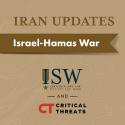Iran Update, March 4, 2024
Mar 4, 2024 - ISW Press
Iran reportedly requested Sudanese permission to establish a permanent naval base on the Red Sea coast, which would support Iranian out-of-area naval operations and attacks on international shipping. The Iranian request to establish a naval base in Sudan is part of growing military cooperation between the two countries. Western media previously reported in January that Iran had recently supplied the Sudanese Armed Forces with Mohajer-6 multirole drones. The Iranian effort to establish a naval base likely reflects how Tehran views its defense exports as a means of facilitating the expansion of its overall military influence abroad.










